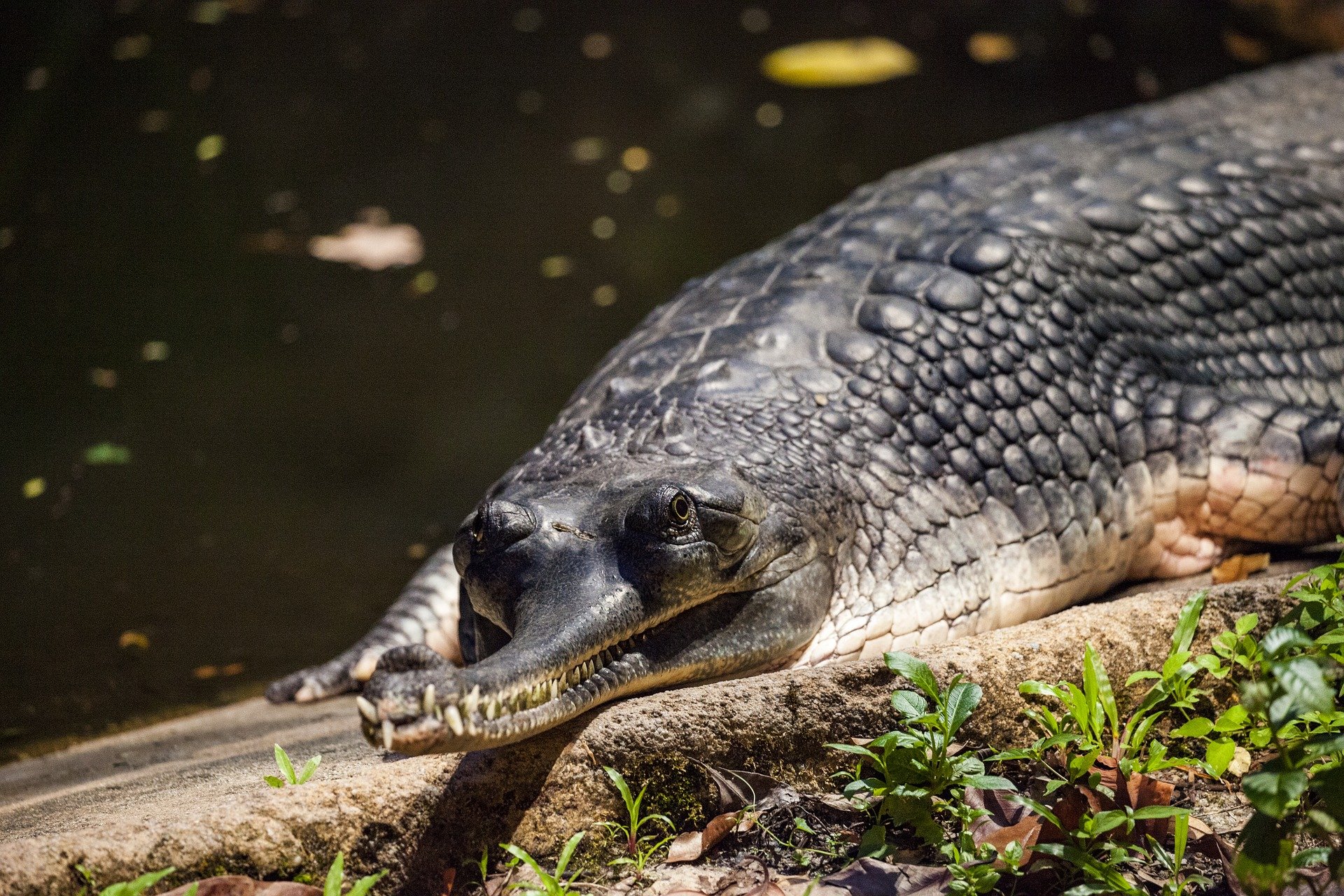
Nepal
Common Name: Gharial
Scientific Name: Gavialis gangeticus

Fact
Gharial eggs are the largest of any crocodilian species, weighing on average 6 ounces (160 grams).
About
Overview:
The gharial is an Asian freshwater crocodile known for its characteristic long thin jaw. It derives its name from the Indian word ‘ghara’ (meaning ‘pot’) which refers to the bulbous growth at the end of its snout.
Found in Nepal, India and Bangladesh gharial populations have declined by approximately 94% from peak levels driven by a number of anthropogenic factors.
Lifespan:
40 - 60 years
Habitat:
The gharial inhabits clear freshwater systems, generally preferring deep and fast flowing rivers. Sand banks are used as basking sites and for nesting during the dry season.
Historically, gharials were found in Nepal, India, Bangladesh, Pakistan, Myanmar and Bhutan but only remain in the first two of these countries.
When to spot:
Gharials can be seen all year around.
Diet:
Gharials predominantly eat fish but larger individuals may prey on vertebrates.
Predators:
The main predators are humans, but Gharial young can be predated by snakes and birds of prey.

Fact
The word gharial is derived from the word ghara, which means mud pot. It was misread by Europeans who changed the word to gavial. Thus, this species is known both as gavial and gharial.
How To Identify
Gharials have a highly distinctive long, thin jaw and bulbous growth at the end of its snout. They have rows of uniform sharp teeth and a relatively long well muscled neck to support them in catching fish.
They are sexually dimorphic with males growing up to 6 metres in length whilst females reaching up to 4 metres. Gharials weigh between 150 - 250 kg when fully grown.
Vulnerability Status
IUCN Red List status: Critically Endangered
Country status: Unknown
Population size: Approximately 650
Global gharial populations have decreased by 94% versus peak levels and by >80% since 1943 with the species becoming locally extinct in Pakistan, Myanmar and Bhutan.
Despite this, there have potentially been signs of improvement in populations and the population trend is currently increasing according to the IUCN red list.
Conservation efforts in India and Nepal have focussed on a mixture of head-starting (conserving and ranching wild eggs) and captive breeding, however, the effects of these programmes have varied. In India, releases in the National Chambal Sanctuary and other areas have managed to arrest and even reverse some population declines, although in Nepal similar efforts have not resulted in any noticeable population increases.
Threats
Key historical causes of decline have been dams and barrages disrupting river hydrology, fishing net mortality and unregulated hide hunting. As human population sizes have increased this has further increased the demand for river resources resulting in additional threats such as water control and extraction and river bank disruption (e.g. sand mining).
Within Nepal a further challenge is the relatively small population of mature adults (<50) within specific locations in which the gharial is found and there are few known examples of recent breeding. Coupling this with a lengthy estimated generation time of 25 years means that population declines may be more difficult to reverse.

Fact
Male Gharials blow bubbles using the bump on their snout.
Conservation Actions
Much of the conservation action supporting gharials has related to rear and release programmes launched in India and Nepal in the 1970s and 1980s. The process of head-starting has been used to incubate, conserve and ranch wild gharial eggs to improve early survival rates and provide a stock of young gharials to release. Successful captive breeding programmes were also set up in India in the 1980s and 1990s in order to produce further young gharials for release.
The success of release programmes has varied significantly. Releases into suitable habitats in the Indian Chambal and Katarniaghat regions have resulted in population increases in some areas. However, other releases - including those in Nepal - have resulted in no discernible population improvements. A lack of monitoring in many areas also creates challenges for understanding what impact releases have had.
What You Can Do To Help
Crocodiles of the World, the UK’s only Crocodile Zoo, are raising public awareness about the importance of gharials and other similar reptiles in the hope of securing their long-term future. Pay them a visit with proceeds and donations going towards funding ongoing conservation efforts.
Consider swapping garments and accessories, such as shoes and bags made of reptile hide for those made from faux materials.
Further Information
Click the title below for further information.
-
The latest IUCN Red List data.
-
The IRCF is an organisation that pursues the conservation of reptiles, amphibians, the natural habitat and ecosystems that support them.
-
The EDGE of Existence programme is the only global conservation initiative to focus specifically on threatened species that represent a significant amount of unique evolutionary history.
Common Name: Himalayan relict dragonfly
Scientific Name: Epiophlebia laidlawi

Fact
Himalayan relict dragonflies are very clumsy in flight, but since they have very few predators in their habitat it doesn’t cause them too many problems.
About
Overview:
Discovered in 1918, for a long time it was thought that the Himalayan Relict was an evolutionary intermediate between dragonflies and damselflies due to some unusual features. A new suborder was created for this in-between stage. It was later discovered that these oddities actually branched off from dragonflies a lot more recently than the damselflies did. So it's not a halfway point at all, but a whole other journey that has left us with just 2 surviving species – the Himalayan relict dragonfly and the Japanese relict dragonfly.
Lifespan:
They remain in the nymph stage for an incredibly long time, developing slowly for 5-6 years (perhaps owing to the cold). Once in dragonfly form they are thought to live for around a month – typical of other dragonflies.
Habitat:
Himalayan relict dragonflies breed in streams in India and Nepal at altitudes between 1,800-3,500m. The species flies at 3000-3650m, thought to fly this high after breeding.
When to spot:
They can be seen year-round but living at very high altitudes.
Where to spot:
Keep an eye out when near streams above 1800m in India and Nepal.
Diet:
Like other dragonflies, they will eat any insect they can catch. Usually mosquitoes and midges but also butterflies, moths, bees and other dragonflies

Fact
The Himalayan relict dragonfly remains in the nymph stage for longer than any other dragonfly or damselfly – typically 5-6 years but has been recorded at over 9 years!
How To Identify
A large black dragonfly with small yellow markings down the body.
Typical dragonfly features of thick body shape (compared to damselflies) and huge eyes, but the wings are typical of damselflies - narrow towards the base, all four are the same size and shape and held up above body when at rest. This is what led to it being mistaken for an intermediate between dragonflies and damselflies for a long time.
Vulnerability Status
IUCN Red List status: Near threatened (unassessed since 2006, needs updating)
Country status: Unknown
Population size: Unknown
Threats
Key threats to species:
The species was subject to research on how species will have to shift their range in response to climate change and it was projected that only the high mountains of eastern Nepal will be suitable habitat in the future.

Fact
Dragonflies in the same suborder as the Himalayan relict dragonfly are believed to have been common in the Mesozoic Era - 252 to 66 million years ago!
Conservation Actions
Having not had its status evaluated for the IUCN Red List since 2006, the Himalayan relict dragonfly requires a new evaluation in order to assess its population size, trends and threats. The IUCN has goals to increase the number of assessments it is doing year on year as well as addressing biases such as invertebrates not being proportionately represented. So keep an eye out to see if the Himalayan relict dragonfly has an update soon!








